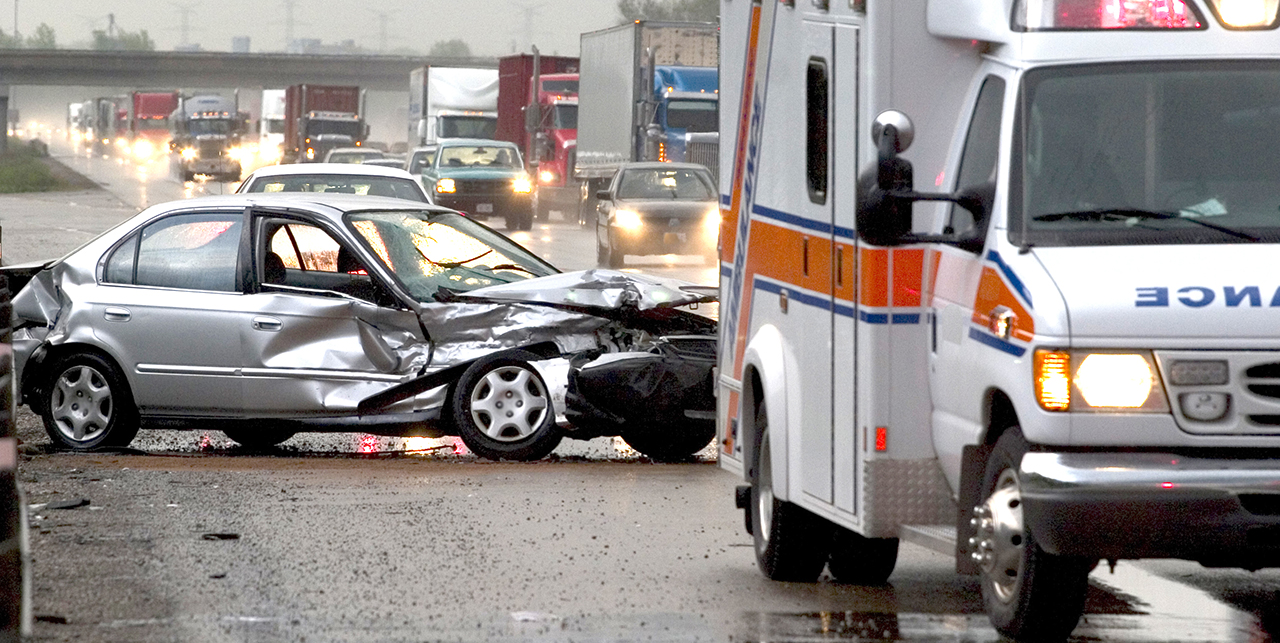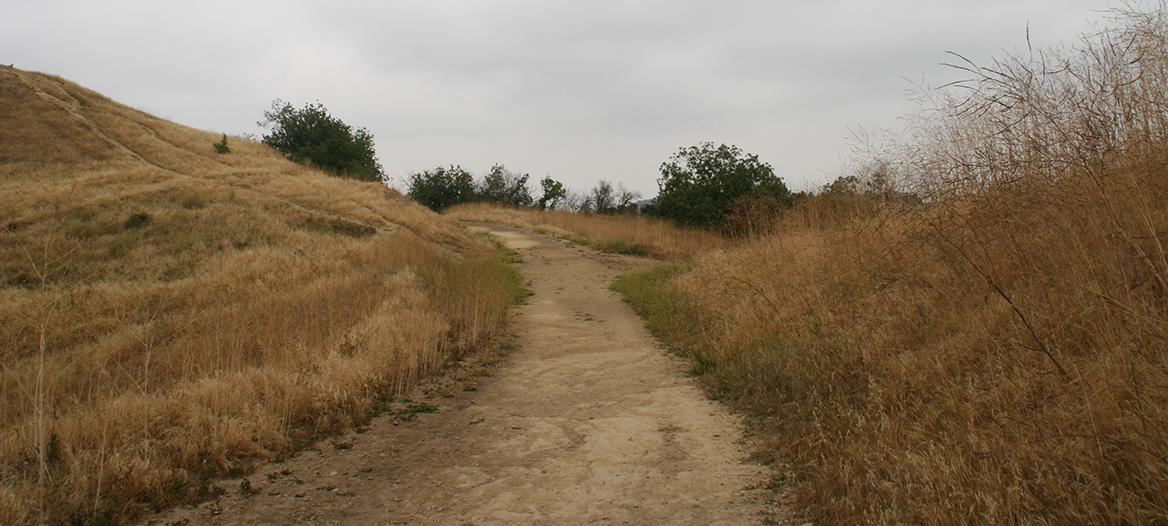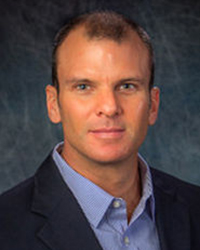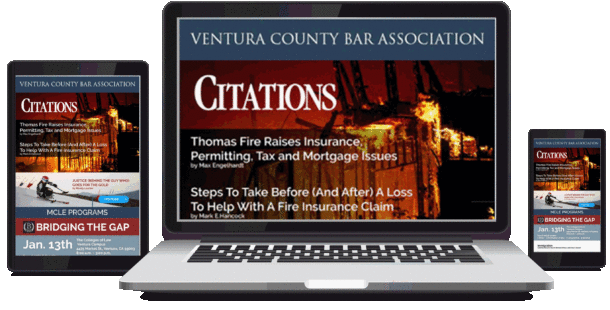
OCTOBER – TWO THOUSAND SEVENTEEN
VCBA MISSION STATEMENT
To promote legal excellence, high ethical standards and professional conduct in the practice of law; to improve access to legal services for all people in Ventura County; and to work to improve the administration of justice.
We Read So You Don’t Have To: Self-Indulgence

CITATIONS EDITORIAL BOARD
Managing Editor
Wendy C. Lascher
Assistant Editor
Cari Ann Potts
Assistant Editor
Heather Deffense
Publisher, CEO
Steve Henderson
Creative
J.P. McWaters
Alice Arnold
Rachel Coleman
Jonathan Gunderson
Karen B. Darnall
Rachael J.Kimball
Panda L. Kroll
Carol Mack
Michael L. McQueen
Rabiah A. Rahman
Lauren E. Sims
Michael R. Sment
Kathleen J. Smith
Al Vargas
CITATIONS is published monthly by the Ventura County Bar Association. Editorial content and policy are solely the responsibility of the Ventura County Bar Association.
Submit all editorial matters to:
CITATIONS
1050 S. Kimball
Ventura, CA 93004
t: 805.659.6800
f: 805.659.6818
wlascher@fcoplaw.com
| ERIK B. FEINGOLD | PRESIDENT’S MESSAGE: THE DYNAMIC DUO | |
| MARK E. HANCOCK | PRACTICAL PRACTICE POINTERS: UNINSURED MOTORIST INSURANCE | |
| JOSHUA S. HOPSTONE | SUPREME COURT ADDRESSES IMPLIED PUBLIC DEDICATION OF PROPERTY | |
| LAUREN CLARK RAD | KNITTING – REDUCE STRESS LEVELS | |
| CASSANDRA WOLF | BOOK REVIEW: THE OUTSIDER | |
| STEVE HENDERSON | EXEC’S DOT…DOT…DOT… |
PRESIDENT’S MESSAGE
by Erik Feingold
One of the joys of my job as your president this year has been to work with, on a nearly daily basis, and to bask in the glow of two of the most dedicated public interest attorneys I have ever had the privilege of working with: our immediate past-president Charmaine Buehner and our President-elect, Mark Kirwin. I have known them each for several years, and I thought I knew them pretty well before this year. But watching them in action has made me truly appreciate their selflessness, drive and commitment, and I wanted to take this opportunity to shed some light on their activities – in front of and behind the scenes – so you too can gain a further appreciation for all that they do and be as proud of them as I am.
As many of you know, in her capacity as the current president of Ventura County Legal Aid, Inc. (“VCLA”), Charmaine resurrected our long-time legal aid clinic and turned it into the vital and thriving organization that it is today. What started in 1996 as the Volunteer Lawyer Services Program turned into a “clinic on wheels” and has now, under Charmaine’s helm, evolved into a bona fide “brick and mortar” operation that has served the needs of literally hundreds of county residents over the past two years alone. The clinic operates the first and third Tuesdays of every month out of the Ventura County Law Library, serving indigent clients with immigration law, family law, civil collections, landlord-tenant, and certain criminal law issues. VCLA recently hosted a Saturday clinic to train attorneys to assist people affected by the upcoming DACA deadline to complete paperwork necessary to extend their DACA rights. The response was overwhelming: by my count over 40 attorneys (including Public Defender Todd Howeth and at least four immigration specialists), paralegals and interpreters turned out. And in what I consider to be a truly “Ventura County” phenomenon, the volunteer-to-client ratio was about six to one. In other words, for every client in need there was a team of approximately six volunteers to help out. A good problem to have!
Fresh off the success of the DACA clinic, on Sept. 21, Charmaine and Rennee Dehesa – another shining star in the Ventura County volunteer legal community – hosted a Family Preparedness clinic to assist families with plans for the care of minor children and financial matters in the event of an emergency such as arrest, deportation or the incapacity of a parent. It happens more often than you would think, and thanks to this clinic more people are informed and ready for such an eventuality.
It should come as no surprise that in recognition of Charmaine’s efforts, the VCLA was the recipient of a $100,000 grant this year, meaning more facilities and more services for impoverished residents of our community in need of legal assistance.
Mark can be counted on to volunteer at not only every VCLA function to assist those with legal needs around town, but also around the world. He, along with his wife Angela, founded the Kirwin International Relief Foundation (www.kirfaid.org), a “humanitarian organization dedicated to helping others help themselves in a respectful and environmentally sustainable manner.” When disaster strikes, at the drop of a hat Mark will stop what he is doing so that he can rally volunteers and circle the globe to assist those in need of assistance, wherever they might be. In the past few years alone, he has traveled to Nepal, Mexico, Haiti, India and Burma to assist with earthquake, typhoon and hurricane relief efforts. At the time of this writing, Mark has “boots on the ground” with a team of volunteers assisting those affected by Hurricane Harvey in Houston. Oh, and in his spare time he does not miss a VCLA, VCBA, Rotary Club meeting (where he is also on the Board of Directors), VCLA volunteer clinic, or VCBA executive committee meeting – and he manages a fulltime litigation practice as an active attorney. Whew.
Charmaine and Mark are truly inspirational, and, by their words and deeds, on a daily basis they fulfill the core purpose of the VCBA to improve access to legal services and make the world a better place to live.
Erik B. Feingold is a litigator with Myers, Widders, Gibson, Jones & Feingold in Ventura..
WE READ SO YOU DON’T HAVE TO: SELF-INDULGENCE
Martinez v. Optimus Properties, LLC (C.D. Cal. 9/7/17) case no. CV 17-3581 and related actions)
ORDER TO SHOW CAUSE RE: DISCOVERY MOTIONS
The Honorable Michael R. Wilner
1. Plaintiffs apparently have a discovery dispute with the defense in these related housing discrimination actions. To advance the dispute, the parties submitted a series of massive filings with the Court.
2. How massive? The joint brief containing the parties’ arguments and an appendix setting forth the discovery requests at issue are 935 pages in total. (CV 17-3581 at Docket # 29.) My computer froze and crashed when I first tried to open them. The exhibits, declarations, and other attachments to the motion consist of 830 additional pages. (Docket # 29-1 through 17.)
3. A total of 1,765 pages — for a discovery dispute? And these submissions are multiplied by five because Plaintiffs apparently filed the same or similar motions in the parallel actions.
4. Let’s say that Judge Milner is a fast reader. Let’s say that he spends only one minute per page digesting the prose and legal research of the Skadden firm (on the reasonable assumption that the defense isn’t driving the bus on these issues). For the Court to read each of the 1,765 pages of the submission once — without looking at a single cited decision, thinking deeply, or sleeping — will take nearly 29 and a half hours. That’s a big part of the work week for a busy judge in America’s busiest federal court.
5. Does the discovery dispute really merit this much paper? Is every page of the briefs and exhibits crucial or even relevant) to the issues in dispute? How would I know? It’ll take me until the end of next week to begin to find out — if I feel comfortable dropping all of the other civil and criminal cases before me between now and then.
6. And I don’t. The Court has real doubts about whether the parties are conducting discovery in the spirit of the Federal Rules. The Court has no way of grasping whether the disputed discovery requests are in any way proportional to the litigation as is fundamentally required by Federal Rule of Civil Procedure 26(b). And, although the parties may have attempted to comply with Judge Wilner’s local procedure of generating an 800-plus-page appendix to avoid wholesale cutting-and-pasting, the resulting legal work product is, quite literally, unreadable.
7. The parties are ordered to show cause why the motions should not be dismissed as self-indulgent. The Court will hold a hearing on the OSC on Friday, September 15, at 8:30 a.m. At the hearing, the Skadden lawyers should be prepared to walk the Court through the discovery motions and address the proportionality problems that are apparent in the filings.
8. Pursuant to Local Rule 37-2.3, the Court will not entertain any supplemental memorandum from any party. The hearing noticed for September 27 is vacated until further notice.
PRACTICAL PRACTICE POINTERS: UNINSURED MOTORIST INSURANCE
by Mark E. Hancock

The first and most basic pointer about UM (aka uninsured motorist insurance) is to always advise clients and friends to never go without it and UIM (underinsured motorist) coverage. While liability coverage is supposedly mandatory in California, there certainly are no guarantees that another driver who injures you, a loved one or your clients, is going to have any, much less adequate, liability insurance. The police are not supposed to stop vehicles for the sole purpose of checking on insurance coverage. (See Veh. Code, § 16028, subd. (a).)
Any attorney handling auto PI cases (and the clients of such an attorney) should know that, if the clients are involved in an auto accident involving injury or property damage of $1,000 or more, the clients have two important responsibilities. One is to make sure a written report is made with the police or CHP within 24 hours, and the other is to file an SR 1 (California Traffic Accident Report) with the DMV within 10 days. The SR 1 Report is how the DMV learns of collisions and triggers the DMV’s check on compliance with the financial responsibility laws. Not filing an SR 1 is against the law. (Veh.Code, § 16004, subd. (a).) While in the past insurance agents often prepared SR 1 reports for their customers, it is this attorney’s experience that this practice is not as common these days. In hit and run UM cases, there is also the requirement of filing a declaration regarding having a claim against an unascertainable person with the client’s own insurance company within 30 days. (Ins. Code, § 11580.2, subd. (b)(2).)
While it may not be fatal to your client’s recovery if they or you do not turn in a DMV SR 1 report within ten days, you should be aware that the DMV won’t do anything for you if they receive an SR 1 Report more than a year after the collision. The “DMV does not accept reports or take actions against non-reporting or uninsured motorists unless this SR 1 form is sent to the DMV … within one calendar year of the accident date.” (SR 1 Form, emphasis in original.) This is important to remember because, although the statute of limitations for UM claims/demands for arbitration is two years (Ins. Code, § 11580.2, subd. (i)), you need to get going on your investigation well before then.
What does/can the DMV do for you? Presumably you already know about the other side’s insurance, or absence of insurance, since parties are supposed to stop and exchange information at the scene, including the name(s) of the driver and the owner of the other vehicle. (Veh. Code, §§ 20000, et. seq. and 40000.1, et. seq.)In the UM context, you are particularly interested in two things: (1) uninsured motorist certificate(s), and (2) appropriate punishment for those who break the financial responsibility law.
Establishing that the other driver or vehicle had no insurance is one of the foundational things one has to do in an UM arbitration. This can potentially be done by way of an Uninsured Motorist Certificate(s) (referred to as SR 19C forms), but you aren’t going to get those unless you or your clients previously (and timely) turned in a SR 1 report! Make sure that your SR 1 Report lists both the driver and the owner (if different) of the other vehicle. Why? You want the insurance info on both. You should be aware that the DMV won’t necessarily address the owner and his or her insurance unless you name him or her in the SR 1. This is so even though they are the ones who provide you with the registered owner information!
Although the other driver is supposed to identify not just him or herself at the scene, but also the owner as well (Veh. Code, §§ 20002, subd. (a)(1) and 20003), in the event that doesn’t happen, you can do an Attorney Information Request (INF 1161E) to get registered owner information. If you do that well within a year and learn of the owner, you can send in an “amended” SR 1 within the year.
Another pointer is that reporting collisions to the authorities is especially important in UM cases. Because the police don’t come to every collision, motorists have to look out for themselves and make sure a police report is promptly filed. This is especially important in hit and run situations. (See Ins. Code, § 11580.2, subd. (b)(2).)
Especially if you believe that we are a nation of laws, and that people should obey the law, you will want the DMV to do something to stop people from driving without insurance. It is not unknown for people to provide false or expired evidence of insurance to try to prevent being cited and/or from having their vehicle impounded. Investigation with the insurer will reveal whether “the insurance” was cancelled, or lapsed.
So, send in the notice of no coverage to the DMV! Doing so will not only help get a SR 19, but also hopefully get the DMV to do something about the offender(s). Presenting false evidence of insurance is a misdemeanor, which can subject the violator to fine and/or imprisonment and suspension of driving privileges. (Veh. Code, § 16030.) You might also remind the DMV and your state representatives that both drivers and owners are supposed to be able to establish financial responsibility “at all times.” (Veh. Code, § 16020 subd. (a).)
The overall lesson here is that, if you want to be able to recover for injuries caused by an uninsured motorist and to see that the financial responsibility laws are enforced, you should be vigilant in reporting to the DMV. Don’t let people who can’t provide proof of insurance and/or who fake insurance information get away with it and go on to hurt someone else.
Mark E. Hancock is an attorney with offices in Ventura. He handles personal injury, real estate and insurance matters for clients.
SUPREME COURT ADDRESSES IMPLIED PUBLIC DEDICATION OF PROPERTY
by Joshua S. Hopstone

The California Supreme Court recently settled an issue of property law that has been festering for nearly half a century. Scher, et al. v. Burke, et al. (2017) 3 Cal.5th 347 confirms that, with limited exceptions, the arcane and confusing doctrine of easement by implied public dedication is dead as a doornail. The high court confirmed that the principal statute addressing the subject, Civil Code section 1009, says what it means and means what it says. Landowners can now rest easy knowing that no use of noncoastal private property by the general public can ripen into a vested right to continue that use permanently.
The case concerned an unimproved road in Topanga Canyon, deep in the Santa Monica Mountains. The road (Henry Ridge Motorway) crossed several large parcels of private property. The plaintiff lived north of the defendants and sued to secure an easement to traverse the road across defendants’ properties. Deeds, maps and other documents were introduced at trial to reconstruct a history of the road in an attempt to demonstrate longstanding public use. There was no direct evidence of use of the road before 1972 (the statutory cutoff for Civil Code section 1009 subdivision (b)), and no evidence of significant public use since then. Beyond the occasional passer-by, the only people who used the road were local residents and their invitees.
The trial court denied all of the plaintiffs’ private causes of action but sustained their claim for implied dedication. Relying primarily on Hanshaw v. Long Valley Road Assn. (2004) 116 Cal.App.4th 471, Pulido v. Pereira (2015) 234 Cal.App.4th 1246, and Bustillos v. Murphy (2002) 96 Cal.App.4th 1277, the trial court held that section 1009(b)’s ban on implied dedication was limited to dedications arising from “recreational use.” The trial court adjudicated Henry Ridge Motorway to be a “public roadway,” open to permanent and unrestricted vehicular use.
A dedication is the application of private real property to a public use by the acts of its owner that clearly manifest an intention that the land be used for a public purpose. A perfected dedication creates a public easement. There are two methods of dedication: statutory dedication and common law dedication. A statutory dedication is accomplished through compliance with the specific requirements of a statute, such as the Subdivision Map Act (Gov. Code, § 66410, et seq.). Common law dedication, on the other hand, is a form of estoppel against the property owner in the public’s favor, arising from the owner’s failure to object to circumstances that indicate an intention to dedicate.
There are two methods of implied dedication: implied-in-fact and implied-in-law. The difference depends on the extent and duration of public use. A dedication is implied-in-fact when the period of public use is less than the period for prescription (five years in California), and the acts or omissions of the owner imply actual consent or acquiescence to dedication. A dedication is implied in law when the public use exceeds the prescriptive period without substantial interference by the owner.
For any dedication, the fundamental requirement is the clear and unequivocal intent by the property owner to dedicate his or her property to a public use. Though the doctrine of implied dedication has existed in common law since the nineteenth century, it entered public awareness when the state Supreme Court decided Gion v. City of Santa Cruz (1970) 2 Cal.3d 29 (consolidated with Dietz v. King). Gion-Dietz involved a stretch of land which the public had historically used to access the sea. The high court held that depending on the facts of a particular case, a public easement by implied dedication could arise regardless whether the land was coastal or non-coastal property and regardless whether the land was a road. The legal community interpreted Gion-Dietz to be an alarming expansion of the already problematic doctrine of implied dedication, fearing that it would result in landowners excluding the public from using private property for recreational purposes.
The Legislature acted “quickly and decisively” to repudiate Gion-Dietz by enacting section 1009 and modifying section 813. Section 1009 (b) states expressly that “no use of such property by the public after the effective date of this section shall ever ripen to confer upon the public or any governmental body or unit a vested right to continue to make such use permanently,” absent an express written irrevocable offer to dedicate. Certain exceptions appear in subdivisions (c) through (f), which impose additional requirements for perfecting a dedication to government entities and/or dedication of coastal property, i.e., property within 1,000 yards of the mean high tide line. The legislative history confirms that the bill was specifically intended to prospectively abrogate the doctrine of implied dedication, except in the coastal zone.
Against this legal backdrop, the Court of Appeal unanimously reversed the judgment concerning Henry Ridge Motorway. (Scher, et al. v. Burke, et al. (2015) 240 Cal.App.4th 381.) Its opinion made clear that in enacting Civil Code section 1009, the Legislature intended to encourage non-coastal landowners to allow entry on to their property by ensuring “no use” of their property, whether recreational or non-recreational, would become permanent. The Supreme Court granted review to resolve the disagreement between Courts of Appeal about whether section 1009 (b) applies to nonrecreational use of private noncoastal property. Setting forth an extensive analysis of the statutory text, legislative history, public policy and plain common sense, the high court unanimously affirmed the Court of Appeal’s decision that the plain reading of section 1009 prevents public use from ripening into a permanent right to continue that use. Inserting an implied exception into the statute for “non-recreational” use not only violates basic rules of statutory interpretation, but fundamentally undermines the purpose for which this particular law was enacted – to encourage public recreational use of private land.
This case was a rare opportunity to reconcile the rift that often exists between usually-conservative property rights advocates and those who seek unrestricted access to open space. The court rightfully acknowledged that if there is even a possibility that allowing public recreational use may risk permanent forfeiture of private property rights, landowners are probably going to err on the side of caution and exclude public use for any purpose. The opinion harmonizes these interests by affirming the strong public policy of our state to encourage recreational use of property (even private property) by the public, while at the same time giving private landowners the protection they need to allow the public to use their land without fear of permanent loss.
Joshua S. Hopstone is one of the lawyers who successfully defended Scher v. Burke in the Court of Appeal and Supreme Court. He is an associate of Ferguson Case Orr Paterson LLP in Westlake Village, where his practice focuses on real estate litigation and appeals. (805) 659-6800; jhopstone@fcoplaw.com.
KNITTING – REDUCE STRESS LEVELS AND HELP KEEP A SENSE OF PERSPECTIVE
by Lauren Clark Rad

Competence MLCE presentations are forever exhorting lawyers to take up hobbies to reduce stress levels and help keep a sense of perspective. There’s some truth to these old clichés – and it turns out one hobby in particular is well suited to lawyers.
Knitting – yes, knitting – is the perfect hobby for lawyers. I learned to knit during my first semester in law school, right around the time final exams approached. It helped me through school, some hard winters, the bar exam and all the way through practice to the present. I’ve always instinctively known that knitting had benefits, but over the last few years, several studies have emerged that back up my instinct that knitting has benefits. Read on for ten reasons why.
1. Knitting helps cope with stress and depression. A 2016 survey of lawyers co-sponsored by the American Bar Association found unusually high rates of substance use and abuse among lawyers when compared to the general population. More than 36 percent of the 11,489 lawyers who responded indicated levels of alcohol or other substance use that were considered hazardous. In that same survey, 61 percent of respondents reported experiencing anxiety, and 46 percent of them reported experiencing depression. Knitting, meanwhile, has been linked to decreased rates of mental health distress and substance abuse. Out of more than 3,500 respondents to one 2013 survey of knitters, 81.5 percent reported an increase in happiness after a knitting session. Some therapists have reported using knitting as part of addiction treatment because it substitutes a helpful activity for a harmful one. If you are stressed out, struggling with depression or coping with substance abuse, knitting can often be part of an effective treatment plan.
2. Knitting has been linked to better memory and brain functioning over time. As the US population ages, more lawyers will be working into their 70s, 80s and even 90s. Knitting is one way to help keep our brains sharp in all stages of professional life. In 2011, the Mayo Clinic studied 1,321 older adults and found that those who did cognitive activities (like knitting) had a 30-50 percent lower chance of developing mild cognitive impairment than did peers who watched TV or read magazines in their spare time. A smaller study at the University of Texas at Dallas found that those who reported high-challenge hobbies, like quilting or photography, showed better memory function and better focus than their peers who did not engage in those hobbies. Also, knitting requires using basic math and spatial thinking, which many lawyers don’t get to use much in their work lives.
3. Knitting gives you a tangible work product. Except for those days where we have a filing or a deal closes, lawyers don’t often have tangible work product at the end of a long day in the office. Knitting provides an effective counterbalance when it feels like we work for hours with nothing to show for it. Knit goods visibly grow as they’re made, and the weight of a knitting project in the hand can be especially rewarding when work provides few opportunities to physically hold the product of your efforts.
4. Knitting helps with focus and listening. If you’ve gone out in public in the last few months, and especially if you’re around kids ages five to thirteen, you’ve probably encountered your fair share of fidget spinners. Knitting is the original fidget spinner with many of the same therapeutic effects. Cat Bordhi, a knitwear designer and former middle school teacher, reports that she noticed a significant positive impact on students with ADHD when she introduced knitting into the classroom.
5. Knitting combats loneliness. A recent Harvard Business Review article makes the case that loneliness is linked to high rates of workplace burnout. Lawyering can be a particularly lonely profession where it’s not uncommon to go hours at a time without interacting with another person. Knitting, on the other hand, is a social activity. Knitters love gathering in groups to stitch and chat, and one of the best ways to learn how to knit is in person, from other knitters.
6. Knitting addresses perfectionism. Lawyers are notorious perfectionists. But when you’re knitting, you can’t be a perfectionist. Nothing handmade is ever perfect, and it’s easy to make mistakes while knitting. But very few mistakes are as bad as they first seem, and most mistakes are fixable. Learning to knit, making mistakes while knitting, and fixing those mistakes is a way to learn that mistakes in other areas of life are usually fixable, too.
7. Knitting has an easy learning curve. Lawyers are no strangers to steep learning curves, but that doesn’t mean we want one in our downtime. Knitting is relatively easy to learn. The basics can be learned in an evening, and more complex skills within a few weeks or months after that. While knitting is a lifetime hobby for many, and some techniques are challenging, the barrier to entry for a beginning knitter is very low.
8. Knitting can be done in small bursts. Lawyers are not known for having abundant free time. Luckily, knitting can be done a few moments at a time, in the little gaps during our days. In law school, I loved using my public transit time for knitting. You can knit a row or two while waiting for everybody to arrive for a meeting, then put it away and pick it up again at lunch for a few more rows.
9. Knitting is portable. Unlike other hobbies, such as woodworking or painting, knitting is extremely portable. It can fit into the ubiquitous black wheelie bag, a small carry-on for work travel or an everyday tote bag. I keep a stash in my desk drawer, just in case.
10. Knitting is quiet. Lawyers spend a lot of time on conference calls and in meetings. If you’re the type to get fidgety during long meetings and find yourself playing Tetris on your phone, knitting is a perfect substitute. Unlike playing games on a phone, knitting actually helps people listen better than they would otherwise (see point five about focus and listening, above).
Lauren Clark Rad is an employment lawyer at Ferguson Case Orr Paterson LLP. You can chat with her about lawyering and knitting on Twitter at @laurenclarkrad, or send an email to lrad@fcoplaw.com if you’re interested in learning to knit or joining a knitting group.
Exec’s Dot…Dot…Dot…
by Steve Henderson, M.A., CAEs
Baltic Cruise? Saint Petersburg, Russia? Copenhagen? David Shain at 659-6800 or dshain@fcoplaw.com… A district attorney in Texas will lose his “Hang Em” specialty license plates after the Texas Department of Motor Vehicles concluded they could be objectionable to the public. Fannin County District Attorney Richard Glaser says he has had the plates for 35 years. He got the idea from the 1968 Clint Eastwood film Hang ‘Em High…
Dien Le was the first of 27 attorneys who guessed correctly the photo in my September column asking to identify the faceless photo with two full shirt pockets of stuff. A good humored Richard Walton has my thanks…
VC Superior Court is soliciting public comment through Oct. 30 regarding the proposed Rules and Forms. The judges would appreciate your comments and you may find the proposals at www.ventura.courts.ca.gov or by contacting Victoria Borjesson at Victoria.borjesson@ventura.courts.ca.gov… A lawyer has resigned from his partnership at a Texas (yes, Texas again!) personal injury law firm after his sexual assault tweet about Education Secretary Betsy DeVos received media attention. Rob Ranco resigned from the Carlson Law Firm in Killeen, the firm’s managing partner announced Sept. 11. Ranco’s tweet read, “I’m not wishing for it…but I’d be ok if #BetsyDevos was sexually assaulted.” Ranco posted the tweet a day after DeVos announced that Obama administration guidance on campus sexual assault will be replaced… Stuart Nielson begins his newest journey as a partner with Nelson Comis Kettle & Kinney LLP Sept. 18…
Did you know that Ronald Reagan aide William P. Clark failed the bar exam the first time, but ended up on the California Supreme Court? Governor Pete Wilson took the bar exam four times before he passed. He went to Boalt Hall. Governor Jerry Brown, who went to Yale, took the exam twice before he passed. He explained that as an undergrad English major, he had tried too hard to make his answers great literary essays the first time… Todd Howeth has been appointed as Ventura County’s new Public Defender, replacing Stephen Lipson. A little reception was held in his honor Sept. 21, inside a local brew house, naturally… For the second time in less than two weeks, a federal judge from the Middle District of Pennsylvania has excoriated a lawyer for a large fee request following a small recovery. In a decision the second week of September, Judge Matthew Brann said lawyer Cynthia Pollick of Pittston had submitted a fee request that “at times, felt more like an attempted bank robbery than a genuine effort to recover a reasonable fee bill.” Pollick had sought $727,000 in fees in a civil rights suit against teachers, principals and administrators that settled against one teacher for $25,000 plus attorney fees. “The vast majority of Ms. Pollick’s entries are larded with excreta unbecoming of any attorney in this district…. These raw, unprocessed entries are inconsiderately supplied in what appears to be size 8-point font or smaller, comprise 44 pages, and frankly sicken both the bench and the bar.”
After 50 years of high drama litigation, Santa Barbara attorney Barry Cappello knows the difference between a seasoned trial lawyer and a palooka. The problem, he said, “is the art and craft of trial lawyering is not taught in law school…. You’ll learn torts, rules of evidence and lots of things, but you won’t learn how to stand, how to address a judge, how to open a case, how to make closing remarks and how to cross-examine a witness.” To rectify this, Cappello donated $1 million to his alma mater, UCLA School of Law…
Steve Henderson has been the executive director and chief executive officer of the bar association and its affiliated organizations since November 1990. He is the author of “How to Herd 1250 Cats” and “It’s Been A Long And Strange Season.” Bryce Harper is staying in Henderson’s home during the playoffs. He may be reached at steve@vcba.org, FB, LinkedIn, Twitter at steve@hendo1, Instagram at steve_hendo, or better yet,
650-7599.
Member Benefits
Mebership Log-in
Lawyer Referral Service
Member Benefits
Mebership Log-in
Lawyer Referral Service
Member Benefits
Mebership Log-in
Lawyer Referral Service
Member Benefits
Mebership Log-in
Lawyer Referral Service

